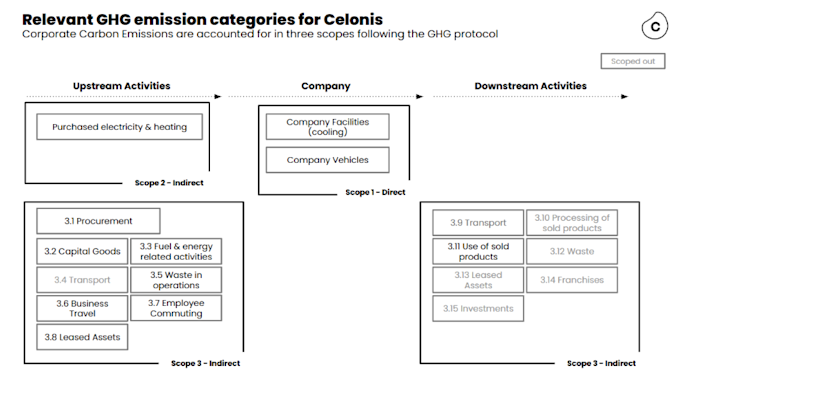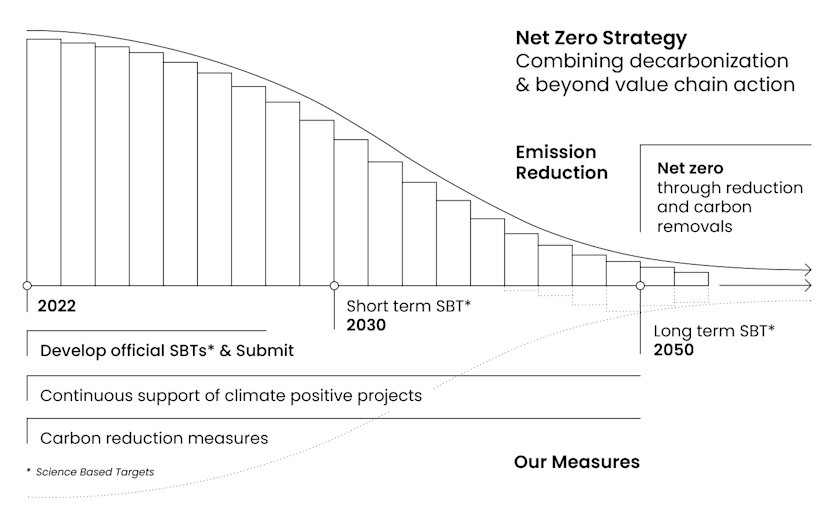
Celonis commits to Science Based Targets initiative: What you need to know
Celonis has committed to set near- and long-term emission reduction targets to align with 1.5°C and net-zero under the Science Based Targets initiative, the leading framework for climate target setting.
With this move, Celonis is joining over 4,000 companies taking action under the Science Based Targets initiative framework. These companies are adopting a framework of near-term and long-term Science Based Targets (SBTs). For instance, a near-term SBT can be to set Scope 1, Scope 2 and Scope 3 targets for 2030. A long-term SBT would include a commitment to reduce emissions to a minimum level no later than 2050 and to neutralize the remaining emissions by investing in projects which permanently remove carbon.
What is emerging from the SBTi effort at Celonis is a set of learnings that other companies can use. Now these best practices and takeaways are a work in progress, but we caught up with Celonis' Viktoria von Waldenfels, Carbon Accounting Expert, to outline what you need to know for your own sustainability efforts.
Before committing to something like SBTi, what do companies need to do?
1. Get your footprint
At Celonis, our goal is to build a strong Net Zero strategy consisting of both decarbonization and so-called beyond value chain mitigation. The decarbonization pillar aims to reduce our own Scope 1-3 emissions based on a science-based path aligned with limiting global warming to 1.5°C through reductions in our value chain. The second part is focused on supporting quality carbon projects outside of our value chain. As for any other company, the decarbonization part should be the priority for now.
The first step to any climate program should be to start measuring your Greenhouse Gas emissions. As we’ve shown in our Baseline and in our recently published Sustainability Report we have started quantifying our carbon footprint as a company. Celonis is not yet legally required to disclose carbon footprint information but any company should start quantifying their emissions as soon as possible since:
the data collection and calculation process can be harder than expected and should be refined over the years;
and without a footprint, you cannot derive reduction measures in a structured way or commit to set science-based targets.
The best practice is to adhere to the principles laid out in the Greenhouse Gas (GHG) Protocol, which provides calculation guidance to all Scopes and sub-categories. Our approach was to find a footprinting provider with an approach which is certified to be aligned with the GHG Protocol to set up our first two carbon footprints for 2020 and 2021. The footprinting results gave us a first overview of our main emission sources, ideas for initial reduction measures and also room for improvement in terms of data quality.
2. Get familiar with SBTi requirements
Adherence to the GHG Protocol is a great first step towards preparing for a SBTi commitment since the SBTi framework builds on the GHG Protocol principles. On top of that, any company planning to set science-based targets at some point should start early to check whether their footprinting approach covers the necessary requirements for science-based target setting (requirements regarding the base year, scoping, and calculation).
The result of our own scoping exercise with our footprinting provider looked like this:

3. Get management and employee buy-in
A footprint alone doesn’t help if you don’t have the necessary support within your company to commit to set SBTs. From our experience it helps to:
Brief executives as thoroughly as possible on the reasons for, timeframe and consequences of a SBTi commitment.
Let employees know what you are planning in terms of your net zero strategy. Even if your net zero strategy isn’t perfect yet, getting employee support and engagement is crucial. Also share your reasoning behind setting science-based targets to show employees a quantifiable framework for climate action claims and reduction efforts.
Set up a training to have everybody learn the key terms of climate action, e.g. the difference between net zero and climate neutrality. We set up two online trainings which are open to all internal and external people in our Academy. See: Celonis Academy's Sustainability Base Camp andSustainability Business Bootcamp.
What is the hardest data to capture?
Procurement data. Like many companies out there, we were only able to capture our procurement emissions at a very high spend-based level at first and are working to refine our data granularity and to work towards primary and activity-based data. Capturing and reducing one’s Procurement footprint is also dependent on collaboration across teams. We are dealing with this topic both as a company on its net zero journey as well as a provider of our Sustainable Spend Management app which helps our customers understand their suppliers’ ESG performance. As we are working to refine our calculations and our reduction measures, we are able to understand the needs of our customers even better.
But I also learned that other categories can be difficult, for example if you are not a manufacturing company (where energy has played a large role for many years) it might be hard for you to gather your energy consumption data across all offices at first. A lot of companies underestimate that task.
Webinar: Process Excellence to Unleash Sustainability Performance
Supply chain optimization, sustainability are blending together
How important is alignment with executives and corporate sponsors?
Very important. It is crucial to make executives and corporate sponsors understand the potential benefits of climate action and also the potential risks of inaction since those are the people on which the sustainability team depends for budget and support regarding:
Footprinting providers (prices can differ dramatically).
Costly or hard to implement reduction measures.
Investments in climate-positive projects and carbon removals.
Renewable Energy Certificates.
Headcount - within the Sustainability team but also other teams which need to build capacity to comply with climate regulation.
What do you see as the potential returns on committing to SBTs?
I see benefits along various dimensions:
Customer value: An increasing number of our customers has science-based targets or a commitment, and our relationships can benefit from us being on the same page.
Brand and talent reputation: Setting SBTs and having a strong sustainability program has been shown to increase brand reputation and to increase employees’ likelihood to stay in a company long-term.
Emission reduction: Between 2015 and 2020, on average, companies with approved targets reduced their Scope 1 and 2 emissions by 29% (Source: SBTi Progress Report 2021).
Regulation compliance and investor confidence: In the face of rapid evolution and adoption of regulations (e.g. Lieferkettengesetz, EU Taxonomy, NFRD + CSRD) we want to get ready to comply with regulations coming our way.
Do you see a day where sustainability will be just part of daily operations at companies? And if so when?
We can see that sustainability is being embedded into more and more departments and processes, but this takes time. Sustainability targets need to be operationalized from being high-level strategic goals towards becoming achievable through day-to-day operations. With our Celonis sustainability applications, we are providing leading solutions aligning with our vision to transform the world and get to a 1.5°C pathway. We are helping our customers operationalize their sustainability targets, which can include science-based targets.
What's next on the Celonis to-do list?
Now the real work begins! In the coming months and years, we want to really decouple our strong growth as a company from our carbon footprint. In the coming months, we will:
Formally prepare our targets and submit them to the SBTi. This includes the involvement of many departments.
Keep driving our reduction efforts which we already kicked off in parallel in Procurement, Office Management and Mobility.
Engage with our suppliers on their climate targets and performance.
Monitor regulatory developments around the CSRD and get ready to comply with the TCFD.







